Tea is something I drink every single day. It’s sacred at my house – I even have a whole drawer devoted to it! I drink it because it is amazing for your health. There are so many varieties of tea that can improve digestion, metabolism and even prevent certain diseases. This investigation into tea ingredients has been in the making for a long time. What I’m about to share with you totally rocked my world forever and I’ll never look at tea in the same way again. Do you really want to know what’s in your tea?…Then read on.
 The ancient Chinese tradition of drinking tea dates back thousand of years to the early Chinese dynasties and aristocrats who drank the beverage for its medicinal properties. In ancient times, leaves from the Camellia Sinensis (the tea plant) were either ground into a powder or placed as loose leaves directly into water to infuse it with herbal essence. Unfortunately, modern day tea is nothing like the unadulterated version of old tea. Many of today’s tea brands are operating under the guise of providing health benefits and promoting clean living, but are actually laden with pesticides, toxins, artificial ingredients, added flavors and GMOs.
The ancient Chinese tradition of drinking tea dates back thousand of years to the early Chinese dynasties and aristocrats who drank the beverage for its medicinal properties. In ancient times, leaves from the Camellia Sinensis (the tea plant) were either ground into a powder or placed as loose leaves directly into water to infuse it with herbal essence. Unfortunately, modern day tea is nothing like the unadulterated version of old tea. Many of today’s tea brands are operating under the guise of providing health benefits and promoting clean living, but are actually laden with pesticides, toxins, artificial ingredients, added flavors and GMOs.
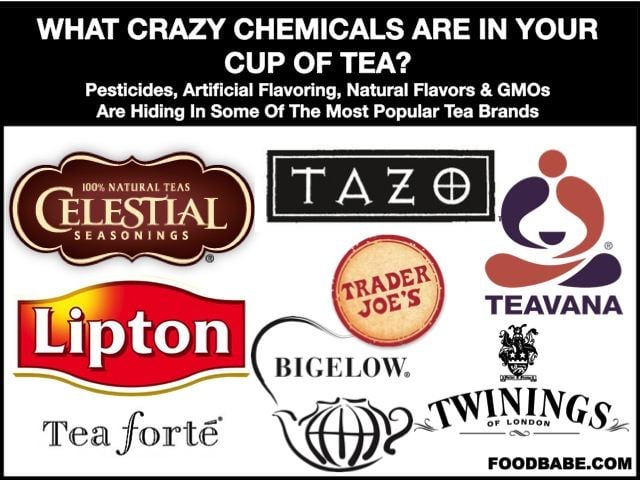
Conventional Teas – An Abundance of Pesticides
Did you know that most tea is not washed before it is put it into bags? That means if the tea was sprayed with cancer-causing pesticides, those pesticides go directly into your cup. And this is the reason why tea is on my organic shopping priority list. To prove this point, here are some shocking facts about one of the most well-known tea brands – Celestial Seasonings.
A recent third-party analysis by Glaucus Research and discussed here found that 91 percent of Celestial Seasonings tea tested had pesticide residues exceeding the U.S. limits. For example, Sleepytime Kids Goodnight Grape Herbal contained 0.26 ppm of propachlor, which is a known carcinogen under California’s Propsition 65.
The “Wellness” tea line was found to contain traces of propargite, also a known carcinogen and developmental toxin. The FDA has already issued two warning letters to Celestial Seasonings in regard to poor quality control according to this source. Imagine what happens when pesticide-laden tea is steeped in boiling water.
If grocery store brands don’t provide a clean option for you, perhaps a high-end loose leaf tea would circumvent some of the issues of grocery store brands. Right? Wrong! Take Teavana, which is found in malls across North America for example. Teavana taps into tea culture with the “Teavana Experience.” Convincing their employees to take customers on a sensory journey – they open a huge canister of loose leaf tea and wave the top of the canister so you can smell the tea – touting all of the wonderful health benefits of tea complete with samples and manipulative demonstrations that end in an expensive visit to the tea shop. Is all the extra money worth it? Are customers getting a superior tea product? No.
Teavana tea was tested by an independent lab and 100 percent of it was found to contain pesticides. One tea in particular, Monkey Picked Oolong, contained 23 pesticides. 77 percent of the teas would fail European Union pesticide import standards, and would be banned from import. 62 percent of the teas tested contained traces of endosulfan, a pesticide that has been banned by the U.S., China, the E.U., and 144 other countries because it has been linked to impaired fertility and could harm unborn babies.
UPDATE (May 27, 2014): Glaucus Research funded the research done by Eurofins Scientific (an independent lab) and admits on their disclaimer that they are biased because they would make money if Hain’s stock declines. However – I am not sure that Eurofins’ research should be completely discounted on this point alone. Since I wrote this post, Celestial has been sued in a class-action lawsuit based on the pesticides that Eurofins found in their teas and for mislabeling of them as “100% Natural”. The jury is still out on whether Eurofins’ research will be considered legit, as this case is still active in California. The Plaintiffs contend that Celestial’s teas contain “pesticides, herbicides, insecticides, carcinogens, and/or developmental toxins (collectively, “Contaminants”)” and Celestial “did not dispute – and has never disputed – that the tea Products contained Contaminants. Nor has (Celestial) challenged the results of the Eurofins Tests” and “has not claimed that Eurofins was biased or that the Eurofins Tests were not, in fact, accurate”. Even if it is determined that Eurofins’ research was not accurate – it’s important to note that Celestial’s tea that was tested is NOT organic and some of this tea is sourced from China. Greenpeace issued a report on the alarming amount of pesticides found on tea from China, followed up by a detailed report on Lipton brand tea from China – in which they recommend only purchasing certified organic tea to avoid these pesticides. Reference law documents: Complaint; Plaintiff’s Memo in Opposition to Motion to Dismiss. Case 8:13-cv-01757-AG-AN
Teas Can Contain Artificial Flavoring, Natural Flavors, and Hidden GMOs
Furthermore, a majority of Teavana teas contain added flavor – specifically “artificial flavoring.” If their tea is so high end, why would they be adding ingredients produced by fractional distillation and chemical manipulation of various chemicals like crude oil or coal tar? Coal tar in my tea? No, thanks.
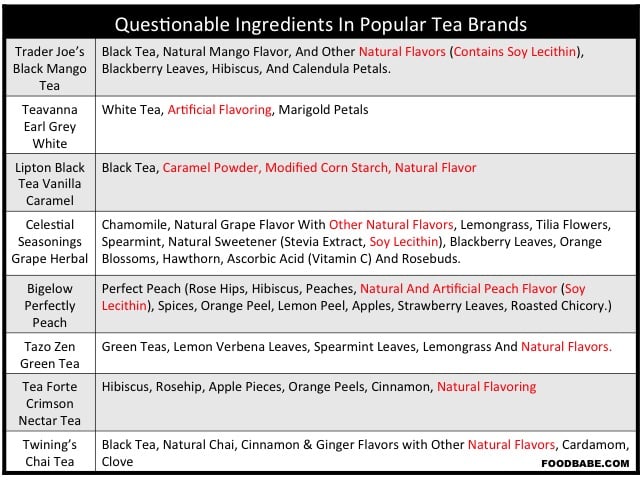
Many popular tea brands get away with using the ingredient “natural flavors” to trick the consumer into thinking they are buying better, cleaner ingredients; however companies are just covering up the inferior taste and low quality of their tea. Fortunately, there are brands that are putting the kibash on the use of natural flavors and using all real ingredients. I was happy to learn that Ahmed Rahim, CEO of Numi Tea is just as disgusted by this ingredient as I am. He said to me “You can breakdown anything that is found in nature and if it ends up tasting like the flavor you wish to use – you can add it to any product and call it NATURAL FLAVOR on the ingredient label. It could come from a stone in the ground and you’d never know.” This is why when I see the words “natural flavor” listed on a label – I put the product down and run far far away. I want to know what I am eating! Don’t you?
Additionally, the added risk of consuming possible GMOs is not something many people think about when consuming teas. Before this investigation and witnessing tea companies using modified corn starch and soy lecithin in tea (additives likely made from genetically engineered corn and soy), I didn’t think about it either! I can’t imagine having a serious soy allergy, considering all the places companies try to hide it.
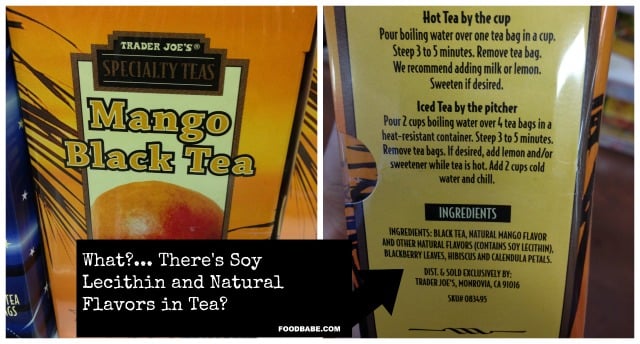
Why The Tea Bag & Packaging Matters
A recent article in The Atlantic discusses the “silky sachet” and “luxurious mesh bags” that hold loose leaf teas (like in brands Tea Forte and Mighty Leaf). Turns out, these modern day bags meant to showcase the tea leaves, are made of plastic.
PLA (polylactic acid) is a (likely GMO) corn-based tea bag material that has attracted major tea companies due to its nice look and its claims of biodegradability. Terms like “silky sachets” and “corn-based biodegradable tea bags” mislead customers into believing a product is more natural and sustainable than it really is. While the processing for PLA removes all traces of genetic material, it is still made with genetically modified corn. Although the actual tea bag is not an ingredient like teas and herbs, it is an element that is put into boiling water.
According to The Atlantic, tea bags are most commonly made from food grade nylon or polyethylene terephthalate (PET) which are two of what’s considered the safest plastics on the scale of harmful leaching potential. However, Dr. Mercola disagrees, he states:
“While these plastics are generally considered among the safest in terms of leaching potential, the molecules in these plastic tea bags may still in fact break down and leach out when steeped in boiling water…” Well, isn’t that how tea is prepared?
Another temperature consumers need to worry about in tea is the “glass transition” temperature. Here’s the science behind the glass transition temperature or, Tg, and why it becomes dangerous according to The Atlantic:
“That is the temperature at which the molecule in certain materials such as polymers begin to break down. As a rule, the Tg of a material is always lower than the melting point. In the case of PET and food grade nylon (either nylon 6 or nylon 6-6), all have a Tg lower than the temperature of boiling water. For example, while the melting point of PET is 482 degrees Fahrenheit, the Tg is about 169 degrees. Both nylons have a lower glass transition temperature than PET. (Remember that water boils at 212 degrees.) This means the molecules that make up these plastic tea bags begin to break down in hot water.”
So, while the plastic itself won’t melt in your tea, the glass transition temperature could potentially leak out harmful phthalates if there are such things in your tea. Another thing to worry about is that some of the newer tea bags are made with a variety of plastics. Some plastics are nylon, some are made of viscose rayon, and others are made of thermoplastic, PVC or polypropylene.
Beware of paper tea bags too, which can be worse than plastic tea bags.
GET THIS: Also according to Dr. Mercola, many “paper tea bags are treated with epichlorohydrin, a compound mainly used in the production of epoxy resins. Considered a potential carcinogen by the National Institute for Occupational Safety and Health2 (NIOSH), epichlorohydrin is also used as a pesticide. When epichlorohydrin comes in contact with water, it hydrolyzes to 3-MCPD, which has been shown to cause cancer in animals. It has also been implicated in infertility (it has a spermatoxic effect in male rats) and suppressed immune function.”
So what do you do the next time you want a cup of tea? Antioxidant rich teas aren’t going to do much to counterbalance the chemicals, additives and artificial flavorings in today’s modern teas.
First, I recommend looking at this chart below to see how your favorite tea brand stacks up:
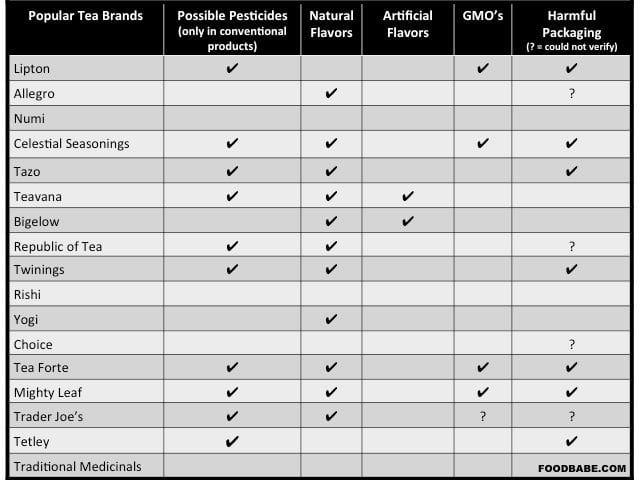
And then when brewing and picking out the safest tea remember these tips:
1. Choose an organic & non-GMO certified brand of tea. (My favorites are Numi, Traditional Medicinals, and Rishi Tea (loose leaf)).
2. Check the ingredient list on the back of the tea package to make sure there are no added flavors, GMO ingredients like soy lecithin and corn starch added to the tea leaves.
3. Make sure the brand you buy uses a safe form of packaging material or buy loose leaf tea and use a stainless steel or glass tea strainer. Have the company verify that bags do not contain epichlorophydrin, and avoid plastic tea bags all together. (Numi and Traditional Medicinals are some of the only brands I trust in this category because they have publicly stated they do not use this harmful ingredient or GMO packaging and are Non-GMO Project verified.)
4. The majority of restaurants use some of the most pesticide ridden tea and brands that have harmful packaging like Celestial Seasonings, Lipton, etc. Don’t fall victim to this. Bring your own tea when eating out or going to restaurants and ask for pot or cup of boiling water (remember to leave a good tip if you do this). I even do this at Starbucks because I like to vote with my dollars and not buy tea brands that are harmful. If you drink iced tea, brew your own at home and carry an insulated water bottle with you.
5. Remember these temps and times for brewing the perfect cup of tea
If you know someone who loves to drink tea, please share this post with them. I was just as shocked as you probably are about all of this craziness – knowing what’s in our tea and what we put in our body matters! Let’s change the world together.
Xo,
Vani




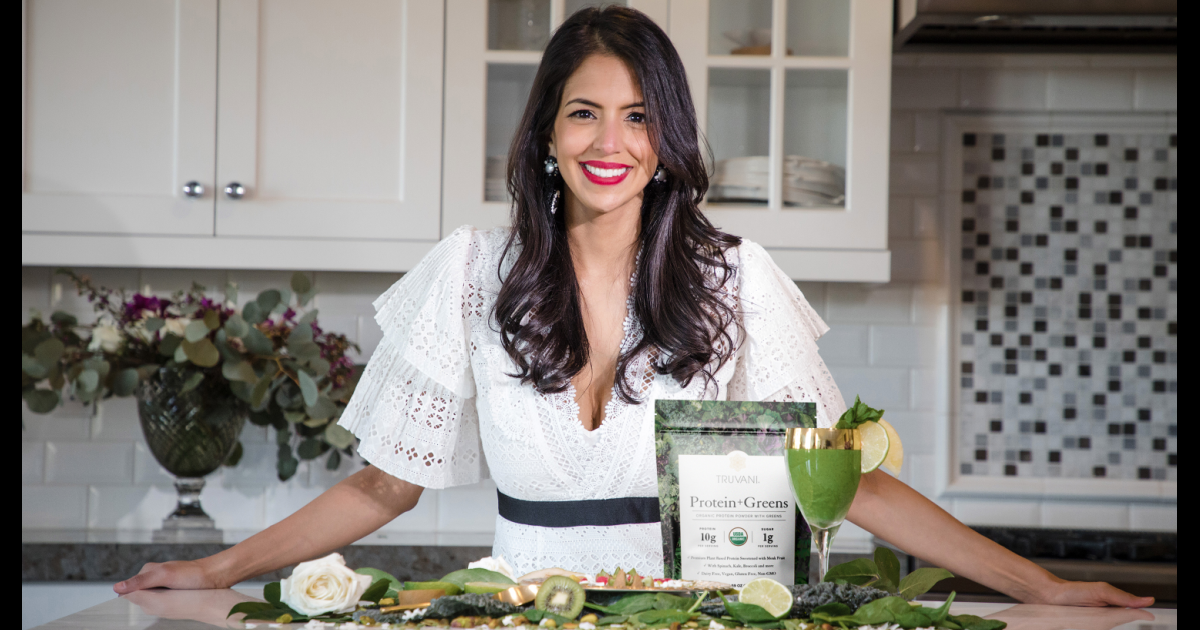
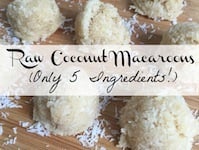
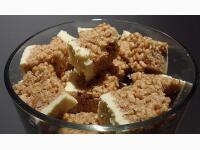


I see a chart above with a column labeled “Toxic Pesticides (only in conventional products).” Now if there are trace levels of pesticide residue (e.g. <1 ppm) but at a level allowed by the USDA why should I be worried? This is an infinitesimal about. Is this really harmful? What is the EU standard and what is the USDA standard? Where is the science behind this?
The concern arises because pesticides can accumulate in your body (this is called bioaccumulation; it can travel up the food chain as well), so that small amount can build up if you drink tea regularly (this can happen with any of the chemicals found in food and drink, as well as exposure from outside sources). And just because the exposure is minute, that doesn’t mean it can’t cause harm. This is called the inverse dose response. For example, a large amount of Chemical X will cause death, but small amounts will cause sickness. Another issue is what could possibly happen when chemicals combine. There are 80,000+ chemicals used, the vast majority of which have not been tested for health risks by themselves, let alone in conjunction with other chemicals. The manufacturers of these chemicals say that it’s the government’s job to make sure they’re safe; the government says it’s the responsibility of the makers. So who’s testing? No one, really. In Europe they operate under what’s called the precautionary principle. Basically that means even if a chemical hasn’t been proven dangerous it’s not going to be approved unless it’s proven SAFE. Here in the States the USDA and FDA are more reactionary: they take action only when a problem arises. I don’t know about you, but I’m not going to put blind faith in a company whose bottom line is making profit.
“This is an infinitesimal about.” I know what you emnt to say….
Why worry about what amount is “safe”? Just get the poisons/ toxins out. As for the science, the human body cannot release these toxins/ poisons fast enough. So, they accumulate in the fat cells, blood stream and works your kidneys doubletime to make up for it.
try this: do agoogle search on “Story of Stuff Project”. They are not the end all in the word against chem/ toxins/ poisons but they do a good fair amount of research on this. also, look up “Safe Cosmetics .org”. With the 10-20+ chemically laced products the avg person slathers on their bodies a day, we are simply over loading our system… babies are no exception.
I run my business on a greener cleaner life and putting the fun back into personal care. If the FDA and USDA are being funded by big busines, ofcourse they are going to decided what levels are safe, and who gets to be the button pusher.
I would like to see a full financial disclosure rather than the .vague paragraph that lacks any real information. This is required in any true research paper.
Yeah, the post of full of non-disclosed Amazon affiliate links, which is not only illegal according to the FTC guidelines, but also in violation of the Amazon affiliate program. Don’t click the links! If you are curious to see the products, open them in incognito windows.
illegal ?!?
while they very well could be described as deceptive or misleading and very well might not comply with Amazon’s affiliate guidelines, I think calling them “Illegal” is a bit of a stretch.
your point is a good point about non disclosed affiliate links but no need for hyperbole to make your point.
My gripe is that there are no links for the original sources or testing sources and information that came up with the results for the pesticide levels. That is what I want to read and see.
what about Tulsi brand?
What about the venerable British giants PG Tips and Ty-phoo? British standards any better than the USA’s? PG tips is a lovely, strong, Assam-dominated black tea and is my go-to for an afternoon pick-me-up. I’d be disappointed if they’re safety standards area as low as, say, Lipton’s. Was surprised to see Tazo with so many toxicity checkmarks. Thanks for bringing this serious topic to the table, Greg
I called Tazo a few months ago to get info on their teas… the phone contact number goes to the Starbuck’s switchboard. Had a hard time obtaining useful information of where leaves are grown, how they’re processed, etc.
This comment is directed to Caroline MacDougall regarding fluoride content in tea. I have read that the tea leaves absorb fluoride from its surrounding soils in addition to its water source. This is a concern to me because I have a thyroid condition and fluoride suppresses the thyroid function. What is your knowledge on the amount of fluoride in teas? Which teas have the least amount of fluoride? Thank you so much for your response.
Tea, particularly tea drinks made with lower quality older leaves, contain high levels of fluoride. Because of these high levels, research has found that individuals who drink large amounts of tea can develop skeletal fluorosis — a painful bone disease caused by excessive fluoride intake.
http://www.fluoridealert.org/studies/tea02/
I use lots of fresh herbs to create teas. We need to have more of these recipes about. Using ginger, mint leaves, holy basil, thyme, lemon, common herbs we can grow or get at a store. Once you realize, these are the things in your tea bag but getting them fresh, brewing them in that form, sipping the cup after the easy process, gives a more healthful experience. More of a true nourishing, a meditation in drinking, fresher ingredients, a true health tonic! Thanks for alerting others of the issues bag teas carry with them!
I would love to see some recipes for homemade tea!!!
Would love to get some recipes for teas and what to put together…and how much of each herb?? if you would be so kind
Thanks
Annie!
I would like to know how a tea like Yogi tea can be certified organic but yet contain chemicals?
It does not make any sense to me that they could certify a product to be organic if the tea itself is organic yet the tea bag contains nasty chemicals.
It all comes down to this… read the ingredient label! Buy organic. Not so difficult. I buy all my tea organic. Or better yet, buy a tea steeper, and put in your own ingredients; buy fresh and organic or straight from the garden!
If you find me a single peer-reviewed article that says any of these things “detoxes” your body, I’ll change my mind. I’ve been studying this topic because “detox” is the new buzz word, and the marketing machine is taking advantage of the uninformed. (It’s like saying a product is “natural.” We all like natural, right? Only the word “natural” has no legal or regulated meaning on food labels. I could mix the byproducts of soybean oil production with food coloring, imitation flavors, and various white powders and sell it as natural without violating any rule or law.)
Perspiration is largely water and salts. While there may be a small amount of other substances in sweat, the function of sweat is to cool the body, not to release “toxins.” There are multiple doctors and professors on record stating this, several of which have been quoted in a recent issue of Women’s Health magazine. You can also find citations in most fitness industry publications, as the “swear to detox” myth has been promulgated to sell everything from hot yoga to heated spin classes.
Respiration is only detoxifying if you are exhaling smoke while smoking. Everything you exhale is the byproduct of gas exchange in the lower lobes of your lungs. The only “toxin” you exhale is carbon dioxide, which is the chemical byproduct of the oxygen exchange process.
Eating fiber is a necessary part of your diet because it forms most of the solid part of feces and because it prevents the absorption of some calories in people with a healthy gut bacteria (the rat studies on this were just published–I’m pretty sure you could find them using google). There is nothing that just randomly sits in your intestines waiting to be pulled or dragged out–the childhood myth that chewing gum rots in your tummy for five years is a myth–all solids from everything you eat are eventually pushed out the anus through the actions of the smooth muscle of the digestive system.
Science constantly renews itself. This is how we KNOW that the liver and kidneys filter unwanted substances out of the body. Science is how we know perspiration does not have a detoxifying effect. Science is how we know that those funny foot pads feel good but do not remove anything from your body, much less a “toxin.”
While I agree with you regarding the abuse of the words “natural” and now “detox” you show no sources for your own “science”. Where are your peer-reviewed articles?
Perspiration is just water and salt and doesn’t detoxify you claim? Then why does it stink? Water and salt don’t stink normally so there’s obviously something else going on.
Yes, things are pushed out the anus eventually butt the longer they hang around in the colon the more damage is done. That’s why you feel like crap when u can’t go. So, you can wait for your “peer-reviewed” articles that you crave. I’ll just listen to my body. That’s good enough for me!
Wow, where to start?
“Science” is pretty well defined by most dictionaries, but the basic concept is that a scientific conclusion is supported by documented facts. In biology and nutrition, that usually means lab experiments and chemical results. There are none to support the conclusion that fiber and/or sweat “detox” the body.
I’m sorry I assume you were familiar with it, but “peer reviewed” literature is a specific kind of published article. It is used to support novel claims and new scientific results. The author submits the paper to a journal, which then submits it to a committee of qualified peers for anonymous review. So for example, for a paper about whether a certain substance causes cancer, the peer review committee could include cancer biologists, epidemiologists, chemists, geneticists, etc. The committee members read the paper and evaluate the methods and data the author used. They then write a critique and report, including whether additional information is required, or whether there are any limitations on the study. (For example, if the study was conducted on pregnant female rats, it might have limited applicability to male humans, or non-pregnant orangatans. Or a committee member might point to too few data points, or a lack of explanation of contrary known data.) The author has a chance to respond, and this process may go back and forth for several rounds. (Using the same example, study data from non-pregnant female rats might still not apply to males—a committee member might point out that the substance in question reacts to female-only hormones.) After both the committee (still anonymous), the journal editor, and the author are satisfied that the paper’s methods and conclusions are as sound as possible, the paper may be published.
Sweat itself does not stink. Your sweat glands—especially those in the armpits, which we most associated with stink—also excrete some oils (helps move the sweat along) Sweat sits on your skin, where bacteria have a field day reproducing and decomposing the substances in your sweat. The by-products of those processes are what cause the stink. This is a well-known and accepted scientific fact. References you can read to support this statement: WebMD, Wikipedia (the article on body odor cites to multiple peer reviewed publications), all of the articles cited in the Wikipedia article, and Unilever’s antiperspirant.com (written in plain language).
The statements I have made regarding sweat and fiber are not new scientific results. You’re asking for a peer reviewed study for statements with the same level of scientific novelty as “the earth is round-ish” and “planets revolve about the sun.” The facts I recited about sweat and fiber are addressed in any 2013 publication date high school or college level textbook on the topics of anatomy (sweat and fiber), kinesiology (sweat), exercise science (sweat), biology (sweat and fiber), and nutrition (fiber). Personally, I would point you to the textbook “Precision Nutrition” with principal author John Berardi, PhD.
Sweating feels really good to my body, and fiber keeps my regular which also feels good. Those feelings are not proof that sweat or fiber “detox” the body in any way.
Deb:
Wow, where to start?
“Science” is pretty well defined by most dictionaries, but the basic concept is that a scientific conclusion is supported by documented facts. In biology and nutrition, that usually means lab experiments and chemical results. There are none to support the conclusion that fiber and/or sweat “detox” the body.
I’m sorry I assume you were familiar with it, but “peer reviewed” literature is a specific kind of published article. It is used to support novel claims and new scientific results. The author submits the paper to a journal, which then submits it to a committee of qualified peers for anonymous review. So for example, for a paper about whether a certain substance causes cancer, the peer review committee could include cancer biologists, epidemiologists, chemists, geneticists, etc. The committee members read the paper and evaluate the methods and data the author used. They then write a critique and report, including whether additional information is required, or whether there are any limitations on the study. (For example, if the study was conducted on pregnant female rats, it might have limited applicability to male humans, or non-pregnant orangatans. Or a committee member might point to too few data points, or a lack of explanation of contrary known data.) The author has a chance to respond, and this process may go back and forth for several rounds. (Using the same example, study data from non-pregnant female rats might still not apply to males—a committee member might point out that the substance in question reacts to female-only hormones.) After both the committee (still anonymous), the journal editor, and the author are satisfied that the paper’s methods and conclusions are as sound as possible, the paper may be published.
Sweat itself does not stink. Your sweat glands—especially those in the armpits, which we most associated with stink—also excrete some oils (helps move the sweat along) Sweat sits on your skin, where bacteria have a field day reproducing and decomposing the substances in your sweat. The by-products of those processes are what cause the stink. This is a well-known and accepted scientific fact. References you can read to support this statement: WebMD, Wikipedia (the article on body odor cites to multiple peer reviewed publications), all of the articles cited in the Wikipedia article, and Unilever’s antiperspirant.com (written in plain language).
The statements I have made regarding sweat and fiber are not new scientific results. You’re asking for a peer reviewed study for statements with the same level of scientific novelty as “the earth is round-ish” and “planets revolve about the sun.” The facts I recited about sweat and fiber are addressed in any 2013 publication date high school or college level textbook on the topics of anatomy (sweat and fiber), kinesiology (sweat), exercise science (sweat), biology (sweat and fiber), and nutrition (fiber). Personally, I would point you to the textbook “Precision Nutrition” with principal author John Berardi, PhD.
Sweating feels really good to my body, and fiber keeps my regular which also feels good. Those feelings are not proof that sweat or fiber “detox” the body in any way.
Hi Elizabeth
Your approach is very scientific. I appreciate that. What are you studying? I am making a documentary and maybe you can volunteer / helping me figuring out such info or make some recommendations. Whats the best way to reach you?
Research Enterohepatic Recirculation and you will understand how fiber can act as a detoxifying agent. It is a bile sequestrant. The liver dumps many toxins into bile which can then be reabsorbed. Fiber blocks the reabsorption of bile leading to the excretion of it (and the toxins). If you really want to detox, eat a few servings of healthy fat (to stimulate the excretion of bile) with a high fiber meal.
Similar to ‘Food Babe’ I am an avid tea cone suer and drink it three to five times a day. Celestial, Teavana, Yogi and Numi teas are my favorites. Teavana is pretty pricey depending on which one you purchase (Maharaja spiced for me). Amandine Rose and Zingiber Ginger are some of my favorites from Teavana. With Celestial Seasonings the flavored green teas, Tension Tamer, Red Lemon Zinger and Mint magic are my faves. All with the exception of Numi teas have something going on in them and I will not support them anymore once I finish them I REFUSE to discard them. from now on, I will try to only purchase teas that are 100%! If I have to, I will purchase from the high end stores. It sounds a drastic but I AM OCD with issues on food consumption.
Thanks for the info.
I was very disappointed as well to discover the disgusting ingredients in my favorite teas. However, I did not wait to finish them; once I knew it contained something risky to my health I immediately stopped drinking it. Yes, it’s a waste of money to throw out that tea but why would you want to ingest more poison, especially once you know it’s there?
http://en.wikipedia.org/wiki/Lecithin#Properties_and_applications
What about Stash teas? http://www.stashtea.com
I would like to know about Stash tea too. Good Nature and Organic India too!
Granted I use the organic variety and don’t have the issue of pesticides or GMOs, but I would like to know about the bags and if they are harmful!
It’s great you told us about the three you use, but what about other GOOD brands and not just the three you drink in particular.
I love Stash Tea! Can we find out more about Stash?
I was wondering about Stash tea as well (since it’s the primary one I drink aside from loose learf). I checked out their website and found this faq page http://www.stashtea.com/info/FAQ#13 according to this they use paper bags without that nasty chemical 🙂 so at least there’s that.
I’d love to know about Stash too. I have a blueberry tea with “natural flavors” which is suspect but want to see before I toss it!
Thank you for the info on stash tea! =) great information, thank for taking the time to find it.
Hey Food Babe can you please do an investigation on keurig coffee brands? I just got a keurig coffee maker and am not sure which coffee brands to buy for it I cant find any organic coffee for keurigs. Can you tell me if you know if Green Mountain Coffee breakfast blend light roast coffee for keurig coffee makers contains GMO ingredients and any other harmful Ingredients? I drink it every morning and love it, but after reading your tea blog I’m petrified of what’s in this coffee. Your expertise is gladly appreciated, thanks.
Hi Rachael – there are several organic brands. You can find them on Amazon. Finding out about the packaging would be a great investigation!
Hi Krista
Somebody here mentioned Rishi tea and Traditional Medicinals tea. Does teh writer of this article has any information on the packaging materials of these tea brands? Please share. Thanks
Rachael,
probably the best and both environmentally friendly option as well as you can choose your own favorite organic coffee is to buy a k-cup for your keurig. http://www.keurig.com/accessories/my-k-cup?cm_mmc=Google-_-Dynamic%20Search-_-Keurig-_-Keurig%20Homepage
I’m sorry, but single-serve makers are completely evil. Plenty of press recently about how bad they are in terms of the environment and waste. There’s not a single sustainable system out there. And it’s extraordinarily more expensive than making coffee yourself. Plus, IMHO, you can’t beat the taste of french press coffee.
http://www.treehugger.com/sustainable-product-design/not-only-are-single-cup-coffee-pods-ridiculous-waste-materials-they-are-worse-waste-money.html
We got into the business of organic tea in the 90’s because of our concerns over pesticide and fertilizer use in tea. Not only does it raise concerns over the environment and health, but it also affects the flavor of tea. We will have to update our article on why we choose organic tea to reflect some of the research you pointed out. Thank you for the insight.
http://www.divinitea.com/why-organic-tea
I would love to get some links or at least where you found all this information. It does not surprise me at all that some of the socalled organic teas had pesticides in them, I did some tea and coffee research online almost a year ago and at least back then because of how tea is grown and where it was almost impossible to tell which were organic or even fairtrade. The tea-growers would just randomly slap organic or fairtrade stickers on some teas or not on others and when they tried to verify the truth of how the teas had been grown that was next to if not impossible. This may have changed since then? And/or maybe there are actually some small growers out there selling to Numi and Rishi. As far as Teavana is concerned just taste their teas and it’s evident that a lot of the flavor comes from flavorings, not just natural things, and a lot of their teas are already pre-sweetened with diffrerent sweeteners.
happy tea drinking to you all,
Ok – so I don’t know what I was thinking when I was reading your article, because I just went back over it and found some links and more information. Thank you for bringing up some very interesting and informative topics.
🙂 Oh good!
Hello Anette
Can you please share the weblinks that validate this article? Thanks.
Hello Anette
Can you please share some links you found that validates this article?
I’m still doing some more research as well, and I haven’t been able to locate my original research as of yet, but here’s an interesting link reg. Celestial seasonings;
http://farmwars.info/?p=10881
Also if you want to get angry watch the Documentary “the bitter taste of tea” reg, fair trade and just tea growing practices in general, not so much about organic tea in this documentary, but it does highlight why organic is so important. I am esp. looking for sources and links for changes that has been made since this movie was produced, but so far I’m not finding much real information or improvement on fair trade tea.
Forget all of those teas. What you should be buying is tea made in America. America’s ONLY Tea Plantation is located just outside of Charleston, SC in Wadmalaw Island, SC.. They don’t use any pesticides, herbicides, fungicides, or insecticides. If you go there, you can see the tea go from plant to bag/box. No tricks or gimmicks, just the BEST tea you will ever taste. You can also order their tea online and have it shipped directly to you. I live nearby and it’s the only tea I drink! BEST TEA EVER!
http://www.charlestonteaplantation.com/
Charleston Tea Plantation is Bigelow. Nice try though.
Not sure what you mean by ‘Nice try though’. Bigelow owns the Charleston Tea Plantation, however, the tea that is grown at the Charleston Tea Plantation is not the same tea with the Bigelow label. Not the same product.
Vani! You Go Honey!! I LOVE your blog! Just saw you on Marie TV and you are doing really important work for the world!! I’m so proud of you for stepping out of the corporate world and into your life’s work! Awesome research! Awesome healing! 🙂
Love and Blessings,
Mary Jane 🙂
Appreciation for a few other great post. Wherever altogether different may possibly any individual obtain that kind of information in this ideal way of writing? I’ve got a business presentation future few days, and I am for the hunt for these data.
Can anyone give me insight as to he source of the supposed gluten in Tazo iced green tea?? I have been searching and NOTHING! I have celiac disease and am wondering if the gluten is hidden in the ‘Natural Ingredients’ tag line. Tazo does not directly answer this question at all….just corporate run around answers.
You do a super job of informing the public about al the GMO’s and other poisons in our food…Trouble is…one would have to spend most everyday checking this and that to make certain one is not eating or drinking something very harmful…I just want you to know that our Creator will soon act in behalf of his highest creation, man and stop all the people who are ruining this earth and the food we eat and bring about a new world of his making right here where man was designed to live…You can learn more about this international website http://www.jw.org that people can access in many languages…Find out about the truth that will really “set you free.”
I want to thank you. My sister in law recently introduced me to your site. Your articles have been really eye opening. I was SHOCKED to find out that the green tea I drank every day for the past year that I thought was so good for me, actually contained pesticides, GMOs and toxic chemicals in the tea bag itself. 🙁 Grrrrrrr.
I greatly appreciate all of the research that you do and the helpful into that you post.
I wanted to comment on this story, because a few weeks ago I decided to take out some unhealthy habits (smoking and fast food) and replace them with new healthier habits (I’m happy to say that 3 weeks later, I’m still smoke free and haven’t had any fast food.) One of the healthy habits I decided to pick up was to drink a large cup of green tea every morning. All of a sudden I noticed that I was having a breakout on my face in the worst kind of way. I had tried everything to combat it. I’m the kind of person that was born with flawless skin. I never get pimples or acne. So when this breakout appeared I thought, well I must need to replace my pillow. After this didn’t work I thought maybe it could be the products I use in my hair, so I started tying up my hair at night. But still the breakout wasn’t getting any better. I started exfoliating. Still didn’t clear up. I then had an “aha” moment and thought about all the new healthy habits I had picked up. I at first thought it could be the increase in protein I had started but found no relationship of acne/breakouts to protein when I looked online. Then I looked up green tea and skin rash. After doing this I found numerous of connections. I immediately stopped drinking the tea and since I’ve stopped the rash/hives has cleared up.
Have you tried a different brand? I like Guayaki Organic Yerbe Mate.
Hello,
I am wondering which teas are OK. Will you provide a list please? Is Yogi alright? What about loose leaf tea? Which brands are safe? The main teas I’m interested in are Green, Oolong, and Chai. Thank you and I’m looking forward to your prompt reply. Have a great day!
Love your site btw! I actually HATED tea until I switched to organic after a health scare a few years ago. The first thing I noticed was flavor, not just with tea, but with everything. It didn’t leave a funky taste in my mouth anymore.
Here in Portland we have the venerable Steven Smith, Tea maker.
Hi food babe,
Really need your input on this – I recently went out to the organic store & purchased rooibos tea. While i was researching the benefits of the tea, I realized it has flouride in it & won’t be suitable for my mum who has hypothyroid.
There were a couple of arguments online that these are naturally found in the tea leaves & that it is fine. As i delve further, I realised most teas contain flouride. Especially black tea.
Could you please share your thoughts on this as am an avid tea drinker & am worried of the effects both for myself & mum. Thanks food babe! 🙂
Thanks for opening my eyes to this. I will never look at tea the same…and we drink tea every day…and am allergic to soy too.
hey i am drinking daintee royal ceylon earl grey tea and i read on ingredients it says “ceylon tea flavoured with oil of Bergamot” that’s all … can anyone tell me if this is a good tea? ( sorry if my English is bad)
So basically we can’t drink or eat anything anymore.
Ugh! Nothing is simple is it? I won’t look at tea the same ever again either. Thanks for this informative article, even if it did ruin my blissfully naive view of afternoon tea. 😉
Geez o Pete. Frustrating. As much as I’m aware of the concerns over just about anything else, including coffee, this one caught me by surprise. Sounds like a task for Environmental Working Group to take up (www.ewg.org).
I’ve always been a strong advocate of tea with all of my patients and usually recommend Republic of Tea (not mentioned), Tazo and Teavana. I’m a very heavy tea drinker myself. Clearly going to have to be much more conscientious.
http://lifecarechiropractic.com/blog/2013/coffee-tea-health-benefits/
Geez o Pete. Frustrating. As much as I’m aware of the concerns over just about anything else, including coffee, this one caught me by surprise. Sounds like a task for Environmental Working Group to take up (www.ewg.org).
I’ve always been a strong advocate of tea with all of my patients and usually recommend Republic of Tea, Tazo and Teavana. I’m a very heavy tea drinker myself. Clearly going to have to be much more conscientious.
http://lifecarechiropractic.com/blog/2013/coffee-tea-health-benefits/
What about David’s Tea?
I’m curious about Davidson’s Tea also? Does anyone know about their quality?
Numi is the tea I drink, although not always easy to find, and it’s amazing. Glad to see it’s free of chemicals, etc, on your list. Thanks for the great article & info.
What about the Four O’ Clock brand? It is Organic & fair trade, but the last ingredient is natural flavour.
What about Amanzi Tea? Any analysis done on that brand?
Thank you for sharing this! It can be difficult to explain the dangers of conventional (and even some ‘healthy’) teas to well-meaning friends, but this is a really well-written post that I’ll be happy to share. =) I have a soy allergy and it was difficult to find teas at first…until I realized which section of the store to check and discovered which brands were pure. =) Now my favorites are Traditional Medicinals, Heather’s Tummy Teas, Numi, and Pukka (most of them…some have natural flavors added and we avoid those). It’s also fun to experiment with making fresh teas from bulk herbs. Thanks again for sharing!
and my beloved Stash?
As a chemist, I always have to discount articles that point to the author having no or limited knowledge of chemistry when addressing chemical topics. I will only address one point here – the molecules in nature responsible for flavors are found in more that one place. Natural flavors can be the same molecule just from a different source, like the licorice flavor in fennel and anise, – two different plants that both contain a chemical that causes the licorice flavor. And distillation in and of itself is not a bad thing, even if it is used in petroleum production (and soap, and whiskey, and you name it!). There is nothing inherently bad about a physical process like distillation. It is just physics and chemistry. (and those are not bad either). That said, I enjoy my local organic tea. But please no ignorant science bashing.
After reading this, what TEA brand would anyone buy?
You are insane! I can tell you about Trader Joe’s since I work there….nothing under our private label has any preservatives or artificial flavoring and NO GMO’S!! Your supposed “truth” as nothing to do with any actual facts, and I have read other blog posts you have written and its all garbage, get a life and stop trying to scare everyone.
I buy lipton tea all the time in the winter which has turned me into a skeptic. But what about the teas bought at the local asian store? Being a foreigner, my family and I honestly love going to asian, indian, and african stores to buy foods for dishes not common to the United States. Well in the case of teas, we love the teas sold by asian stores. Especially the ginger tea (great for colds). I hope those are healthy enough because the labels are all in Chinese plus they have no nutritional facts listed.
What about Red Label?
What about pewter or silver or silver plated tea strainers?
I order my teas online for 8 years from the same store, they rate #1 online store for 5 years – they have hundreds of varieties, big discounts, free shipping, no taxes. http://www.iherb.com/mypage/avaglow — apply coupon code from this page and get $10 off when you shop first time.
Arbonne has a wonderful detox herbal tea with all botanical ingredients. My homeopathic Doctor LOVED it and even took me off of one of the supplements he had been giving me because I was drinking this tea. Please email me at [email protected] if you are interested in getting more information or trying some.
yO!
foodbabe u rock ^^
please share with me your current (assorted) tea collection!
i would like to gift some to those who recently helped my family through a difficult time.
THANK YOU!~!
What do you think of the Pukkha and Organc India/Tulsi brands?
Just yesterday I opened my pantry to get some tea, and the GMOs came spilling out of the tea and killed my poor cat!
Then, without any warning, I suddenly dropped dead of “horrible evil toxin” poisoning!
If only I never ate anything that had ever been exposed to this planet, I might have lived. But no, I chose to eat, drink, and even *breathe* on this planet, so that’s it for me. Everything is poison and tea is the absolute worst poison of them all.
If only they warned us about this sooner.
Did you know that the company that did the research is a “short sell” investment company. They are betting on a stock going down. So a negative finding that impacts the sale of a product makes them money.
I’m not saying the research is necessarily faulty, but you gotta think that they might have ulterior motives. If it was an independent lab, I would put more faith in the results.
Definitely needs a look into though.
I had to comment. For one, because I am thankful. A customer linked this article to me as the reason why she had gone looking for a company like us.
I apologize for the shameless self promotion, but it plays directly into what you’ve written here.
Our tea ingredients are all organic when possible, and ethically wildcrafted when I cannot get them organic. I blend them myself. No middlemen once the herbs get to me.
As far as containment, our standard tin-tie bags are compostable. For now, you have to peel the labels off as I have not found a soy-based ink for our printer as yet…. and the bags we use if you ask for the bagged option are the Rishi. The ones with no checks on your table of nasty doom.
Thank you for calling attention to this issue, and if you feel like looking into our teas –
http://www.etsy.com/shop/DesertSageNatural